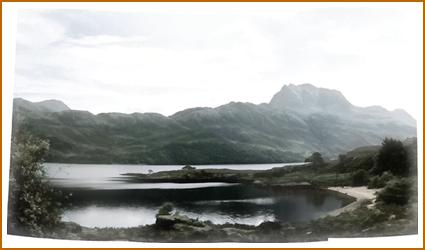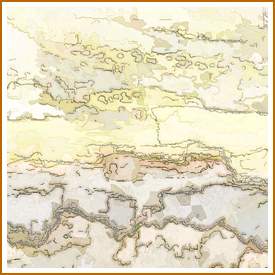|
I work with photography and the computer.
I have always needed to use photography in my professional life and have always had a working knowledge of the camera sufficient to fill my practical need until I became dissatisfied with the limitations inherent in photographing my landscape designs. I was working on a fairly large park in Pennsylvania and wanted to capture the sweeps of my landforms and so experimented with
panoramic photography.
I learned how to take a series of pictures which would then be stitched together in the computer to form a single, very wide image. I learned the basics of digital image manipulation to achieve a decent, straightforward panorama with even exposure and color balance.
 |
In learning this foundation of technique, there is a wonderful scope for play, for
taking the color balance controls, for example, to extremes. There is also a great temptation to be self-indulgent. Just because you can make granny's face green,
doesn't mean you should! But I played -- and I learned. I learned to the extent that I no longer needed just to be amazed at what I could do, but to the point that
the computer became a natural means of expressing what I needed to convey about the world I see.
For the most part, the software I use is Adobe Photoshop. Apart from the basic
tools to balance the color and tonal values of the image, the program can impose filters on an image and can compose the image with layers. A filter is a process that is applied to the image to extract certain information. In film photography you
may place a color correction filter on the lens so that the camera extracts an image made up of only a certain section of the spectrum or one that shifts or
enhances one portion of it. In the digital world, filters may be as simple as that, but the notion of extracting information from a scene, the image captured in the initial photograph, can be
extended to extracting a great variety of information. For example, the edges of shapes in the image can be emphasized and extracted, or just the green components of the edges of the
shapes. Some filters simplify the scene so that, for instance, all shapes smaller than 3 pixels in width are eliminated; some
distort the scene as if you had placed a patterned glass screen in front of the lens. or one that shifts or
enhances one portion of it. In the digital world, filters may be as simple as that, but the notion of extracting information from a scene, the image captured in the initial photograph, can be
extended to extracting a great variety of information. For example, the edges of shapes in the image can be emphasized and extracted, or just the green components of the edges of the
shapes. Some filters simplify the scene so that, for instance, all shapes smaller than 3 pixels in width are eliminated; some
distort the scene as if you had placed a patterned glass screen in front of the lens.
What really makes them
a sensitive and powerful tool for the artist is the ability to combine them with image layers.
In simple terms, you could run 15 filters over an image and each resulting version of the original could have its own layer.
Those 15 layers would be combined to produce a finished picture that might, for example, have green edges snaking around a diamond faceted version of the
scene that emphasizes the red end of the spectrum. But the layers have even more power. You do not combine them solely by changing their transparency.
You can overlay in such a way that the second layer lightens the first, or darkens it, or shows the difference between the two -- in all, you can combine layers in a
multitude of different ways. Many of my prints are the result of dozens of different operations. Sometimes I develop a version of the image and then a second and a
third, each the result of several operations. These composited versions are then combined for the final image.
The changes I make are similar to the interpretations or renderings of the reality
of a scene as painters (and, indeed, photographers) have always pursued.
The metaphor for me is that I am not changing the appearance of the scene I photographed. I am changing my eyes. I am changing the way I
look at the scene -- it is I who changes. |